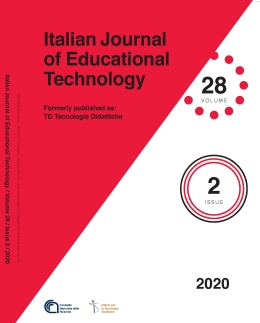Innovation in Teacher Education
Main Article Content
Abstract
[...] We wanted to gather colleagues who have tested new methods and strategies that allow prospective teachers to face the current global challenges. However, our attention is not only focused simply on “how” technologies allow us to identify new perspectives but also on “why” we must multiply our efforts to give the teachers of future generations more intellectual and technical solutions in order to develop new meaningful learning environments. Innovation in teacher education means creating educational paths, where trainee teachers feel they are becoming part of a historical process in which past and present are continuously interwoven (Gadamer, 1979).
In several teacher education institutions around the globe, digital innovations are supporting the education of future teachers. [...]
Article Details
Section
Authors who publish with this journal agree to the following terms:
- Authors retain copyright and grant the journal right of first publication with the work simultaneously licensed under a Creative Commons CC BY 4.0 Attribution 4.0 International License.
- Authors are able to enter into separate, additional contractual arrangements for the non-exclusive distribution of the journal's published version of the work (e.g., post it to an institutional repository or publish it in a book), with an acknowledgement of its initial publication in this journal.
- Authors are permitted and encouraged to post their work online (e.g., in institutional repositories or on their website) prior to and during the submission process, as it can lead to productive exchanges, as well as earlier and greater citation of published work (See The Effect of Open Access)
References
Gehlen, A. (1988). Man, his nature and place in the world. New York: Columbia University Press.
Giri, A. K., & Clammer, J. R. (2014). Philosophy and anthropology: border crossing and transformations. London: Anthem Press.
Koops, M., & Hoevenaars, M. (2013). Conceptual change during a serious game: Using a Lemniscate model to compare strategies in a physics game. Simulation & Gaming, 44(4), 544-561.
Molnár, G., & Szüts, Z. (2018, September). The Role of Chatbots in Formal Education. In 2018 IEEE 16th International Symposium on Intelligent Systems and Informatics (SISY) (pp. 000197-000202). IEEE.
Turing, A. M. (1950). Computing Machinery and Intelligence. Mind 49: 433-460.
Van Ginkel, S., Gulikers, J., Biemans, H., Noroozi, O., Roozen, M., Bos, T., Van Tilborg, R., Van Halteren, M., & Mulder, M. (2019). Fostering oral presentation competence through a virtual reality-based task for delivering feedback. Computers & Education, 134, 78-97. https://doi.org/10.1016/j.compedu.2019.02.006
Van Ginkel, S., Ruiz, D., Mononen, A., Karaman, C., de Keijzer, A., & Sitthiworachart, J. (2020). The impact of computer‐mediated immediate feedback on developing oral presentation skills: An exploratory study in virtual reality. Journal of Computer Assisted Learning, 36(3), 412-422. doi/full/10.1111/jcal

